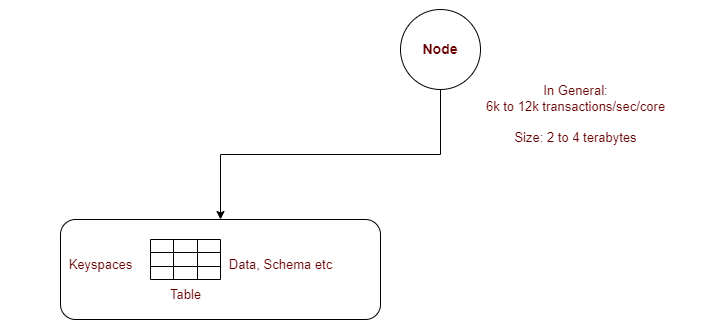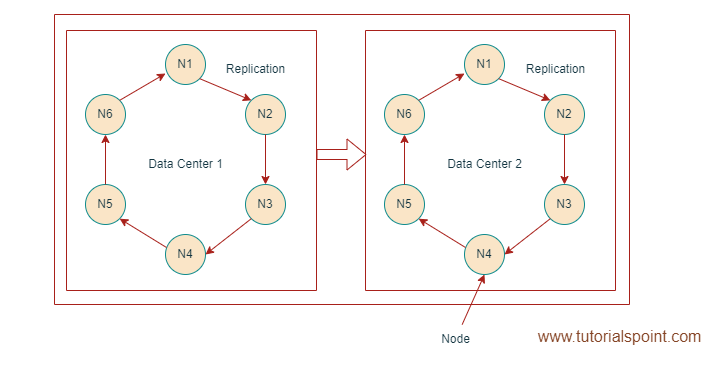
 Data Structure
Data Structure Networking
Networking RDBMS
RDBMS Operating System
Operating System Java
Java MS Excel
MS Excel iOS
iOS HTML
HTML CSS
CSS Android
Android Python
Python C Programming
C Programming C++
C++ C#
C# MongoDB
MongoDB MySQL
MySQL Javascript
Javascript PHP
PHP
- Selected Reading
- UPSC IAS Exams Notes
- Developer's Best Practices
- Questions and Answers
- Effective Resume Writing
- HR Interview Questions
- Computer Glossary
- Who is Who
Node in Apache Cassandra
Cassandra is developed by the Apache Software Foundation. It is a NoSQL database management system. Cassandra utilizes a wide column store to efficiently handle large volumes of data across multiple commodity servers. It is an open-source platform. It offers high availability without a single point of failure. Cassandra is written in Java.
The distributed architecture of Apache Cassandra allows for scalability, fault tolerance, and high availability. Nodes are an essential concept in Apache Cassandra's distributed architecture.
In this article, we will discuss an overview of nodes in Apache Cassandra, their types, operations, and adding/removing nodes in Apache Cassandra.
Node in Apache Cassandra
In Cassandra, each node holds the actual data along with information such as its location, data center details, and more. It also contains keyspaces, tables, and the data schema. Operations such as reading, writing, and deleting data can be performed on a node. Nodes are components of Cassandra clusters. Nodes form a ring-like structure where each node is connected peer-to-peer and is equivalent to every other node in the cluster.
Types of Nodes
In Apache Cassandra, there are three types of nodes: seed, regular, and client nodes.
Seed nodes are responsible for bootstrapping the cluster. It discovers other nodes in the cluster.
Regular nodes store data and participate in read and write operations.
Client nodes are used to access data stored in the cluster. But they do not store any data themselves.
Consider three data replicas stored on separate nodes in a Cassandra cluster. In such a scenario, when you request to read data, any of the nodes can respond. This highlights the effectiveness of the concept of distributing data across a cluster, as it enables a high availability mechanism in Cassandra.

Nodetool
Nodetool is a node management utility tool that provides node health, node, and cluster information. By using nodetool commands, you can access all necessary node information. Commands like "help," "info," and "status" provide general information about the node. Nodetool is located in the bin/ folder by default, where Cassandra is installed.
Basics Nodetool commands
Nodetool provides several basic commands. These commands can be used to manage nodes in Apache Cassandra. Some of these commands are ?
`help` It lists all available nodetool commands.
`status` It displays the status of the node and reports basic health information.
`info` It provides information on the current settings and statistics of the node.
Example - `nodetool status`
Node Operations
Nodes in Apache Cassandra perform various operations to ensure data consistency and fault tolerance. Read and write operations are performed by nodes to store and retrieve data. The gossip protocol is used by nodes to communicate with each other and share information about the cluster. Anti-entropy operations are performed by nodes to detect and repair inconsistencies in the data. Repair operations are performed by nodes to reconcile differences between nodes in the cluster.
Adding and Removing Nodes in Apache Cassandra
Adding new nodes to an Apache Cassandra cluster is a straightforward process. New nodes can be started. It will automatically join the cluster and receive a copy of the data. Adding nodes helps to achieve scalability and distributed processing. Removing nodes from an Apache Cassandra cluster is also possible.

When adding a new node, the process is called bootstrapping, and the default token allocation algorithm randomly assigns tokens to the new node. However, there is a newer algorithm that assigns tokens based on the load of existing virtual nodes for a given keyspace. It is also possible to manually assign tokens or skip the bootstrapping process entirely. When removing a node, the ranges the old node was responsible for are assigned to other nodes, and data is replicated there. The article also explains how to move a node's position in the ring and how to replace a dead node. Finally, the article discusses how to monitor progress during these operations and how to clean up data after range movement operations.
Conclusion
In conclusion, Apache Cassandra is a highly scalable, fault-tolerant NoSQL DBMS. It utilizes a distributed architecture to efficiently handle large volumes of data across multiple commodity servers. Nodes are components of Apache Cassandra's distributed architecture.
In Cassandra, each node holds actual data along with information such as its location, data center details, and more. There are three types of nodes: seed, regular, and client nodes. Node operations are: reading, writing, and deleting.. Nodetool is a node management utility tool that provides node health, node, and cluster information. Adding and removing nodes in Apache Cassandra is a straightforward process that helps achieve scalability and distributed processing.
Apache Cassandra offers high availability without a single point of failure. It is an open-source platform written in Java that provides an efficient way of handling large volumes of data.

